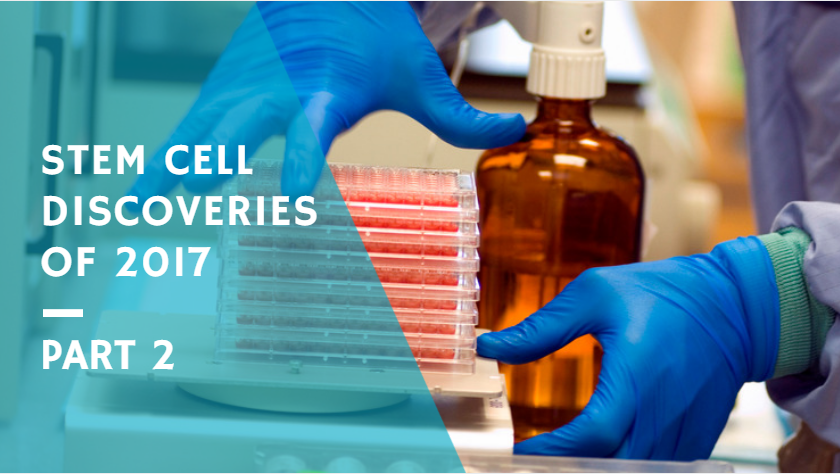
Welcome to part two of our recap of the best stem cell discoveries in 2017. In this article, we will highlight even more incredible stem cell discoveries that and potential treatments for conditions heart failure, lung disease, and arthritis.
Promising Results for Experimental Stem Cell Treatment for Stroke
Stroke is the leading cause of long-term disability in developed nations. A stroke causes serious brain injuries that affect a person’s ability to talk or walk. It can also cause paralysis, which makes simple tasks like eating or holding objects difficult.
A new study has found that stem cells can be used to repair brain damage after a stroke has occurred. The study involved 129 patients, with about half receiving the stem cell treatment and the remainder receiving a placebo. Initial results from the treatment have been very positive. Read more about this research
Stem Cell Treatment May Restore Vision of Damaged Corneas
Researchers from the University of Georgia have published a paper that details a new stem cell treatment for treating damaged corneas.
The cornea is the clear layer on the front of the eye that covers the iris, pupil, and anterior chamber. A damaged cornea can dramatically affect the quality of a person’s eyesight. Unfortunately, it is currently difficult to heal a damaged cornea and patient’s often have to receive a limbal cell transplant from a donor.
The researchers discovered that the cells that work best for repairing the cornea are softer. They then developed a process that sorted stem cells to find the best cells for transplantation. Read more about this research
Using Stem Cells to Predict Toxicity of Chemotherapy Drugs
Chemotherapy remains the most effective treatment for most forms of cancer, including Hodgkin’s lymphoma and leukaemia. Unfortunately, chemotherapy drugs have some very serious side effects. Some of the strongest chemotherapy drugs can even cause heart failure and heart arrhythmias.
A paper published the journal Science Translational Medicine describes a new procedure that uses stem cells to test the potential severity of chemotherapy side effects on individual patients. The scientists start by obtaining some skin cells from a patient, then changing those cells into induced pluripotent stem cells (iPSCs). The iPSCs are then changed into heart muscle cells.
The chemotherapy drugs are tested on the heart muscle cells to check if they produce any serious side effects. This new process could save the lives of thousands of people. Read more about this research
UW Treats First Patient in Stem Cell Therapy Trial for Heart Failure
A group of American researchers have developed a new stem cell therapy that can reduce damage to the heart after a heart attack. The treatment, called CardiAMP, can be used to reduce inflammation around the heart and reduce heart damage.
The procedure begins with doctors obtaining some bone marrow cells from the patient. They cells are processed then injected into the patient. They quickly migrate to the heart and begin repairing any damage that has been done. Read more about this research
New Technique Helps Determine How Stem Cells Differentiate
The ability of mesenchymal stem cells (MSCs) to differentiate into many types of cells is particularly interesting for researchers in the field of regenerative medicine. Learning how the cells know which type of cell to change into is an important question that scientists are just starting to understand.
Researchers have discovered a variety of chemical signals and environmental factors that play a role in determining what an MSC changes into. However, it is difficult to replicate these factors in a laboratory environment.
In 2017, Japanese scientists developed that a agarose gel confinement system that can emulate the environment within the body. This development will make it easier to understand how MSCs differentiate, improving research outcomes. Read more about this research
Cord Blood Growth Factors to Identify Babies at Risk for Lung Disease
Bronchopulmonary dysplasia-associated pulmonary hypertension (BPD-PH) is a lung disease that can affect infants who are born prematurely. It is an often-fatal disease that prevents blood vessels from carrying enough blood to the heart and lungs.
New research published in the Journal of Pediatrics describes a new test that will help doctors determine is a premature baby has BPD-PH. It checks levels of two cord blood growth factors, granulocyte colony-stimulating factor (G-CSF) and placental growth factor (PlGF). This new test could save the lives of thousands of premature babies. Read more about this research
Researchers are Using Edited Stem Cells to Fight Arthritis
Arthritis affects millions of people around the world. It is a painful and debilitating inflammatory condition that mostly affects older people.
Researchers in the United States have developed a new treatment for arthritis that uses gene-edited stem cells. The treatment is called Stem cells Modified for Autonomous Regenerative Therapy (SMART). Gene-edited stem cells are transplanted into the patient, where they begin to reduce inflammation and develop into cartilage cells. Read more about this research
Using Stem Cells to Grow Working Inner Ear Parts to Treat Deafness
More than 360 million people around the world suffer from severe hearing loss. Many of these cases are caused by physical damage to the components of the inner ear.
Researchers from the Indiana University School of Medicine have been using stem cells to grow inner ear organs. It has taken three years of research to reach this point, but the researchers have now created fully-developed inner ear organoids. The next step will be transplanting the organs into patients with hearing loss. Read more about this research
Thanks for reading A Recap of the Best Stem Cell Discoveries of 2017: Part 2. You can continue reading about the many amazing stem cell discoveries in 2017 in part 3 of our series.
{{cta(‘d59882b5-74e2-4033-be94-d4c340e1978c’)}}


